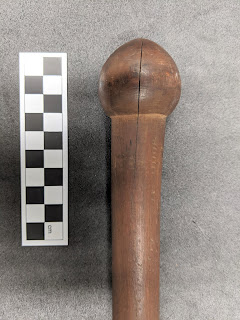This object
is a long wooden staff from UCL’s Ethnographic Collection. Its accession number
is R.0045. It has a wooden round, ball-shaped attachment at one end (see Figure
1).
Figure 1: Staff, Object R.0045
This staff is
142 cm long. It appears to be carved in wood and then polished for smoothness. It
is possible to see the tool marks made by carving, at the top of the object where
the ball-like shape is connected to the staff and along the length of the staff.
This staff is
from Zimbabwe. It was a part of the George Henry Walker’s Collection.
George Henry walker lived in Bulawayo in about 1910. The object was donated by his
niece G. Penwarden after his death. According to the UCL database, this
object is a “plain wooden staff”. However, this staff resembles “knobkerrie” — a weapon used in Zimbabwe.
The history
of the staff, provides an understanding of its significance to several groups of
people. Firstly, a staff in itself, if considered as a walking stick, falls
into a category of household objects that have been a necessity for the elderly
and the disabled. Secondly, this object was for personal use for its original
owner. Therefore it could be significant for their descendants.
On the other hand, if this object is a knobkerrie, it has
cultural and historical value for two stakeholder groups — the people from Zimbabwe,
and the students and admirers of Zimbabwe’s culture and history. Moreover, as a
knobkerrie, this object was used in different ways by two different
communities. The differences in the use, adds another aspect to the value of
this object.
The staff or knobkerrie
is currently stored by hanging it on a metal rack by tying it with twill tape.
Overall this object is stored in a stable condition. However, certain parts
of this object show signs of deterioration. They are indicated in Figure 2.
Figure 2: Illustration of signs of deterioration on the staff
There are water stains on
the length of the staff in 4 locations (see Figure 2). There is a crack on the
ball or knob shaped part of the staff (see Figure 3). It starts in the middle
of the knob and continues onto the length of the staff.
Figure 3: Crack on the staff
There is an old sticker
on the staff. Some discoloration of the wood is visible where the sticker has
been peeled off (see Figure 4).
There is a new scratch on
the staff (see Figure 5) that was not observed until the last examination. These
signs of deterioration need to be monitored to prevent further damage.
Figure 5: New scratch on the staff





No comments:
Post a Comment